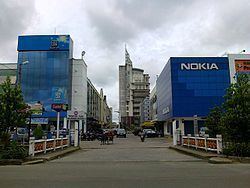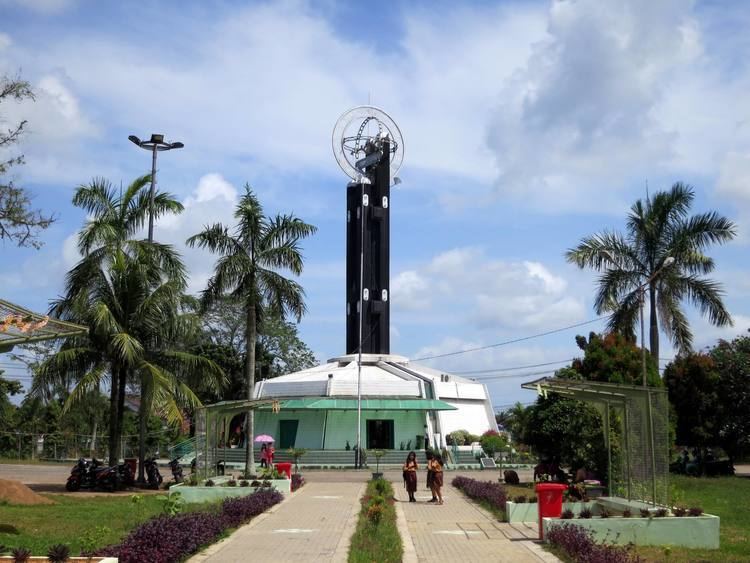Country Indonesia Founded 23 October 1771 | Province West Kalimantan Area 107.82 km2 Mayor Sutarmidji | |
 | ||
University Tanjungpura University | ||
Map of Pontianak, Indonesia
Kota Pontianak is the capital of the Indonesian province of West Kalimantan, founded by Syarif Abdurrahman Alkadrie as a capital of Sultanate of Kadriyah ( Kesultanan Kadriyah ) in 23 Oktober 1771 / 14 Rajab 1185 Hijriah. Syarif Abdurrahman Alkadrie developed Pontianak as a trading port on the island of Borneo, occupying an area of 107.82 km² in the delta of the Kapuas River. It is located precisely on the equator, hence it is widely known as Kota Khatulistiwa (Equatorial City). The city center is actually less than 3 kilometres (2 mi) south of the equator.
Contents
- Map of Pontianak Indonesia
- Pontianak city
- Gardenia resort and spa in pontianak indonesia
- Legend
- Early Development
- Colonial Rule
- Geography and Administration
- Time Zone
- Climate
- Administrative divisions
- Ethnicities
- Language
- Economy
- Industry
- Agriculture
- Trade
- Education
- Tourism
- Cuisine
- Transportation
- References

Pontianak city
Gardenia resort and spa in pontianak indonesia
Legend
The city was formerly the capital of the independent Sultanate of Pontianak and was founded on 23 October 1771 around an old trading station on the Borneo coast. It is built on swampy ground that is subjected to regular flooding by the river, requiring buildings to be constructed on piles to keep them off the ground. Pontianak name refers to a story about ghosts that people in West Kalimantan refer to as Pontianak (a ferocious female ghost in Malay); it was a ghosts' nest until Syarif Abdurrahman Alkadrie and his Army fought and extruded ghosts who attacked his group by shooting cannon balls. He then built a mosque and a palace, exactly on the location of the ghosts' nest, and settled. The mosque and the palace became the first buildings in Pontianak City. To this day, Pontianak people shoot made up cannons from logs every Ramadhan and holiday events to pay attribute to the Sultan.
Early Development
The history of the city of Pontianak written by a Dutch historian, V.J. Verth in his book Borneos Afdeling Wester, whose content is slightly different from the version of the stories circulating in the community today.
According to him, the Dutch started to go to Pontianak in 1773 from Batavia. Verth wrote that Syarif Abdurrahman, son of Sharif Hussein bin Ahmed cleric Alqadrie (or in another version called Al Habib Husin), leaving the kingdom Mempawah and began to wander. In the region of Banjarmasin, he married the sister of the Sultan of Banjar Sunan Nata Nature and sworn in as the Prince. He was successful in commerce and accumulate enough capital to arm ships and boats Pencalang lancangnya, then he started to take the fight against Dutch colonialism.
With the help of Sultan Sand, Syarif Abdurrahman then successfully hijacked Dutch ship near Bangka, also British and French ships in the port of Pasir. Abdurrahman became a rich man and then tried to establish a settlement on an island in the Kapuas River. He found branching Porcupine River and then to develop the area into a prosperous trading center. This is the region that is now called Pontianak.
Colonial Rule
In 1778, Dutch colonialists from Batavia entered Pontianak, led by Willem Ardinpola. Netherlands when it occupies an area opposite the imperial palace now known as the Land of a Thousand or Verkendepaal area.
On July 5, 1779, the Netherlands made an agreement with the Sultan of the indigenous people of the Thousand in order to serve the area of activities of the Dutch nation which later became the seat of government Resident het Hoofd Westeraffieling van Borneo (Regional Head residency of Borneo West) and Asistent Resident het Hoofd der Affleeling van Pontianak ( Resident assistant Chief of Pontianak regency). This area then became Controleur Onderafdeeling van het Hoofd Hoofd Pontianak or Plaatselijk Bestuur van Pontianak.
Assistant Resident het Hoofd van der Afdeeling Pontianak (Pontianak Regent sort of) set Plaatselijk Fonds. The agency manages eigendom or government wealth and take care of tax funds. Plaatselijk Fonds later renamed Shintjo during the Japanese population in New York City.
Geography and Administration
Pontianak City lies on the Equator track with a height ranging from 0.1 to 1.5 meters above sea level. Cities are separated by the Kapuas Besar River, Kapuas Kecil River and Landak River. Thus Pontianak city is divided into three parts.
Time Zone
In 1963 by Presidential Decree No. 243 In 1963, the City entered into the zone Central Indonesian Time (WITA)
But, on January 1, 1988 by Presidential Decree No. 41 Year 1987. Together with the Central Kalimantan, West Kalimantan previously entered zone of Central Indonesian Time (WITA) turning into a zone of Western Indonesian Time (WIB). So that in 1988 the city of Pontianak celebrate New Year twice: at 00:00 am in GMT+8 and then 00:00 am in GMT+7.
Climate
Pontianak features a tropical rainforest climate under the Köppen climate classification (Af) with no distinct seasons at all. The city experiences a large amount of rainfall throughout the year, averaging 3,210 mm (126 in) of precipitation annually. Only in the month of August does the average monthly precipitation fall below 200 mm (7 7⁄8 in). Temperatures are consistent throughout the course of the year, with average high temperatures of 30 °C (86 °F) and average low temperatures of 23 °C (73 °F).
Administrative divisions
Pontianak City comprises six administrative districts (kecamatan), listed below with their populations at the 2010 Census:
Ethnicities
The 2010 census enumerated Pontianak's population at 554,764; the latest official estimate (from January 2014) is 573,751. Pontianak is a diverse and multicultural city. Its population mainly consists of Malays, Chinese and Dayak, with several minorities ethnics such as Bugis, Javanese, Madura, and etc.
Language
The native language and main lingua franca of the city is Pontianak Malay, a distinct variety of Malay that is closely related to Sarawak Malay in neighbouring Sarawak, Malaysia as well as Johor-Riau Malay in Malaysia, Riau and Riau Islands in Indonesia and Singapore. The main differences between Pontianak Malay and Indonesian is that they use "Kamek" instead of "Kami" and "Kitak" instead of "Kalian". However, many people in the city also use Indonesian as their second language. Other ethnic groups like the Chinese mostly are Teochew with a small Hakka speakers, Dayaks and others mainly use their respective languages.
Economy
Most of Pontianak city's economy relies on industry, agriculture, and trade.
Industry
the number of large and medium industrial enterprises in the city of Pontianak that were recorded during 2005 was 34 companies. Labor absorbed by industrial enterprises amounted to 3,300 people consisting of 2,700 production workers and other workers or administration of 600 people. Moderate or major industrial companies located in the District of North Pontianak absorb the largest labor, ie 2,952 people.
The resulting output value of large industrial enterprises or medium amounted to 1.51 trillion rupiah, where large industrial enterprises or are located in the District of North Pontianak dominated by rubber industry companies, while the smallest output value derived from companies located in the District Pontianak City, worth 2.85 billion rupees.
For Gross Value Added (NTB) obtained from all large industrial enterprises / medium in Pontianak City during 2005 amounted to 217.57 billion rupiah and indirect taxes obtained amounted to 462.78 million Rupiah, while the value added at factor Fees earned amounted to 217.10 billion rupees.
Total industrial business unit, labor, the value of investments and the value of sales of small industrial centers of the type Industry Results of Agriculture and Forestry (IHPK) shows that the small industrial centers kinds IHPK most is the attempt snack food industry is centered in Sungai Kuhl with labor absorbed as many as 329 people, the value of investment reached 249.50 million and the sales value amounted to 780.50 million. While the water taro woven industry in 2005 only has 16 business units with an investment of 17.5 million amount and value of sales of 110 million Rupiah located in Tanjung Hulu, Pontianak East.
Agriculture
In 2006, the result of crops most were are cassava, rice, yams. Residents also farmed vegetables and aloe vera. Fruit plants that many in the city of Pontianak is jackfruit, banana, and pineapple.
Farms in Pontianak consists of cattle (beef and dairy), goats, pigs, and chickens (race and native).
Trade
Trade is one of the rapidly growing business in the city of Pontianak. Modern trade began to develop in 2001 with the founding of Mal Sun Apartments in Dubai City. Modern shopping centers began to be built in various corners of the city, such as Ayani Mega Mall and Mall Pontianak. Various national retail companies starting their business in Pontianak.
Education
There are colleges and universities operated by both state institutions as well as private and religious institutions. The University of Tanjung Pura, a state university, was established in Pontianak in 1963. Other universities are maintained by private institutions: Muhammadiyah University, University of Widya Dharma, University of Panca Bhakti, STMIK, (STAIN), POLNEP AKBID St Benedicta, etc.
Tourism
The cultural diversity in Pontianak presents various events throughout the Year. The Chinese celebrates Lunar New Year, Cap Go Meh (Lantern Festival, which falls on the fifteenth day of the first month of lunar calendar), and Cheng Beng (Tomb Sweeping Festival, on first day of the fifth solar term of lunar calendar). The Malay celebrates Idul Fitri, Idul Adha, Maulidur Rasul and The Dayak People celebrates harvest or locally known as Gawai Dayak. These events are usually marked with extravagant cultural parades around the city.
The equatorial line passing Pontianak is marked by an Equatorial Monument north of the city center. Between March 21 - 23 (spring solstice) and September 21 - 23 (autumn solstice), solar culmination can be observed near the Equatorial Monument, where the declination of the Sun will be exactly at 0° at noon (12:00), causing shadow of the Monument and everything nearby to disappear for a few seconds.
Cuisine
Pontianak also known as culinary attractions, with mix of Malay and Indonesian. Diversity makes Pontianak food as a culinary paradise. The food was well-known among other things:
Transportation
The most popular mode of transport is motorbike. Public transport includes minivans (local: opelet), GoJek service and human-powered becaks (three-wheel pedicabs). There are some city buses serving certain routes only. Intercity buses take passengers to other nearby cities (2, 3, to 10 or more hours of travel), and even to Kuching, a city in Malaysia. Road transportation to Malaysia and Brunei is possible via Jalan Trans-Kalimantan(Jalan Lintas Kalimantan) to Tebedu in Sarawak.
Transportation to other parts of Indonesia is mainly via Supadio International Airport. There are more than 10 flights every day connecting Pontianak and Jakarta. There are also flights from and to Yogyakarta, Surabaya, Batam, Kuching, and Kuala Lumpur. Sea transport connects Pontianak to Jakarta, Semarang, Cirebon, and some other cities, including regional cities such as Ketapang in the southern part of West Kalimantan.
